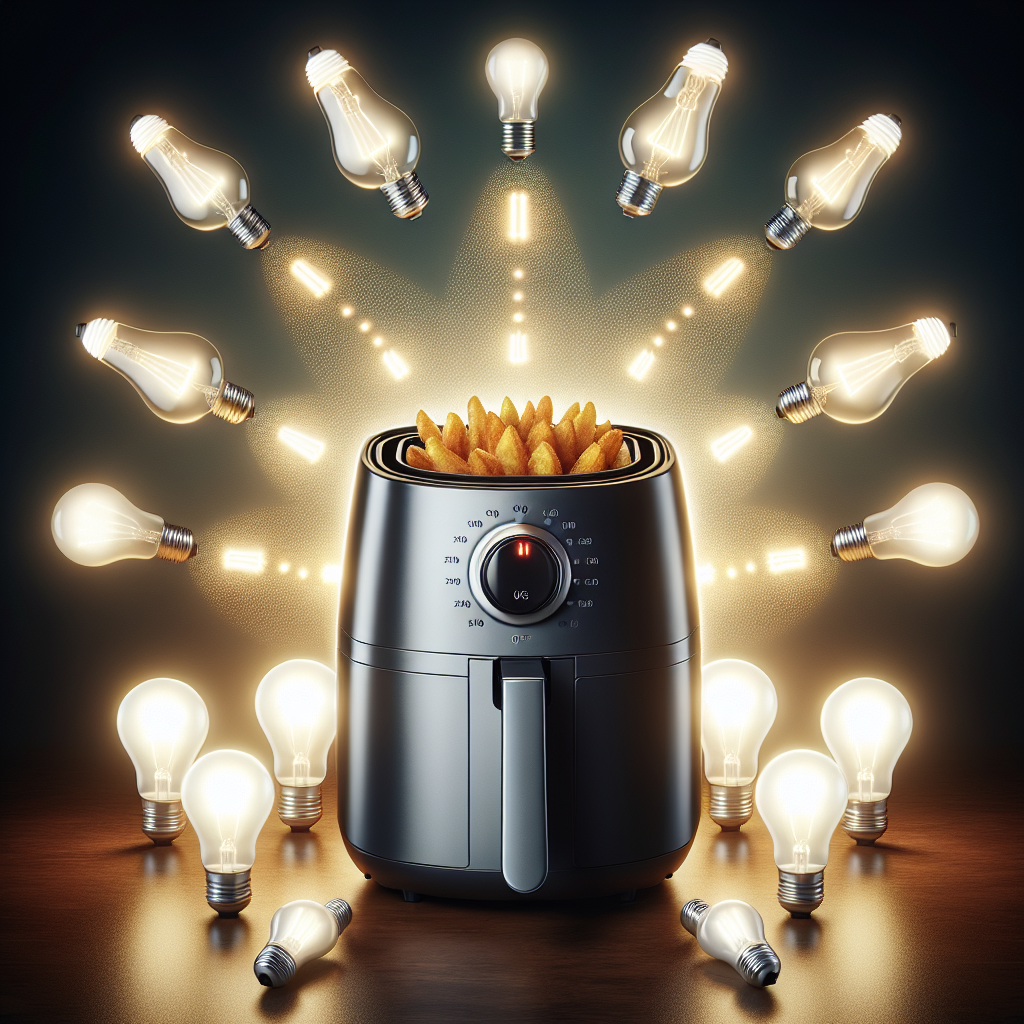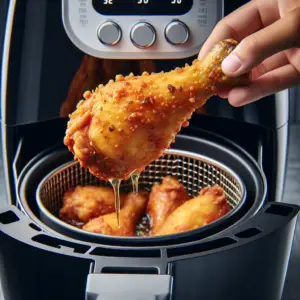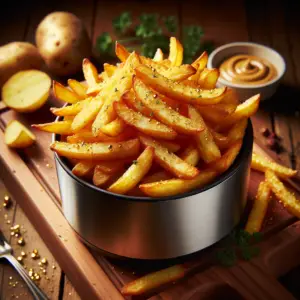Are you considering purchasing an air fryer but concerned about its impact on your electricity bill? Wonder no more! In this article, we will demystify the common question of whether air fryers use a lot of electricity. As we explore this topic, you will gain a clear understanding of the energy consumption of these kitchen appliances and be able to make an informed decision about incorporating one into your cooking routine. So, let’s dive into the world of air fryers and discover the truth about their electricity usage.
How Do Air Fryers Work?
Air fryers have become increasingly popular in recent years as a healthier alternative to traditional deep frying. If you’re curious about how air fryers work and want to understand their impact on electricity usage, you’ve come to the right place. In this comprehensive article, we will explore the technology behind air fryers, compare them to traditional deep frying methods, and delve into the factors that affect electricity consumption. By the end, you’ll have a solid understanding of air fryers and be equipped to make informed decisions about their electricity usage.
Overview of Air Fryer Technology
Air fryers utilize advanced technology to cook food using hot air circulation instead of oil. They are equipped with a heating element and a fan, which work together to heat the air inside the cooking chamber. The heated air is then circulated rapidly around the food, creating a crispy outer layer while keeping the inside tender and juicy. This process is known as convection cooking and allows you to achieve the texture and flavors of deep-fried food without the excessive use of oil.
Comparison to Traditional Deep Frying
When comparing air fryers to traditional deep frying methods, the first notable difference is the amount of oil required. While deep frying involves submerging food in a large amount of hot oil, air fryers typically require just a fraction of the oil or even none at all. This significantly reduces the calorie and fat content of the cooked food, making air frying a healthier option.
Another advantage of air fryers over deep frying is the ease of use and convenience they offer. Unlike deep fryers, which often require precise temperature control and attentive monitoring, air fryers have preset cooking functions and intuitive controls that make cooking a breeze. Additionally, air fryers eliminate the need for frequent oil changes and the disposal of used oil, making them a more eco-friendly choice.
Understanding Power Consumption
Now that we have some background on air fryer technology and its comparison to traditional deep frying, let’s explore the factors that influence electricity consumption. By understanding how these factors impact power usage, you can make conscious decisions to optimize energy efficiency while using your air fryer.
Factors Affecting Electricity Usage
Several factors play a role in determining the electricity consumption of an air fryer. By taking these factors into account, you can estimate and manage the power consumption of your appliance effectively.
Power Rating of Air Fryers
The power rating of an air fryer is a crucial factor in determining its electricity usage. The power rating is usually measured in watts and can range anywhere from 800 to 1800 watts, depending on the model. Higher wattage air fryers tend to heat up faster and have shorter cooking times but may consume more electricity during use.
Preheating Time
Preheating is an essential step before cooking with an air fryer. Preheating allows the cooking chamber to reach the desired temperature, ensuring even and efficient cooking. However, preheating can also contribute to electricity consumption. Longer preheating times will require more energy, so it’s essential to minimize preheating when possible.
Cooking Time
The cooking time of your air fryer plays a significant role in determining electricity consumption. Longer cooking times will, naturally, use more electricity than shorter ones. However, the energy required also depends on the specific recipe and food being cooked. Understanding how to optimize cooking time and adopting efficient cooking techniques can help minimize energy usage.
Frequency of Use
The frequency at which you use your air fryer will also impact its electricity consumption. If you use your air fryer regularly, it will contribute more to your overall energy consumption. Keeping track of usage and finding ways to reduce usage when possible can help manage electricity costs in the long run.
Type and Quantity of Food Being Cooked
Different types and quantities of food require varying amounts of energy to cook. Foods that require longer cooking times or higher temperatures will naturally consume more electricity. Additionally, cooking large batches of food at once may use more energy compared to smaller quantities. Being mindful of the type and quantity of food being cooked can help optimize energy usage.
Now that we’ve explored the factors that influence electricity consumption, let’s delve deeper into power rating and energy efficiency.
Power Rating and Energy Efficiency
Understanding the power rating of your air fryer is essential when it comes to managing energy consumption. Here, we’ll discuss power rating in more detail, explore different models and their power ratings, and touch on energy efficiency ratings.
Understanding Wattage
The wattage of an air fryer refers to the power it consumes during operation. Higher wattage appliances often have shorter cooking times but may use more electricity overall. It’s essential to find a balance between power rating and cooking efficiency to optimize energy consumption.
Different Air Fryer Models and Power Ratings
Air fryers come in various models, each with its own power rating. When purchasing an air fryer, it’s essential to consider your cooking needs and the power rating of the appliance. Smaller, compact air fryers typically have lower power ratings, while larger models may have higher power ratings to accommodate larger food quantities.
Energy Efficiency Ratings
Some air fryers may come with energy efficiency ratings, similar to other kitchen appliances. These ratings provide an indication of how efficiently the appliance uses electricity. When comparing different air fryer models, considering their energy efficiency ratings can help you make a more informed decision.
Comparing Electricity Usage to Other Kitchen Appliances
To put air fryers’ electricity usage into perspective, it’s helpful to compare them to other common kitchen appliances. In general, air fryers tend to be more energy-efficient than ovens and stovetop cooking methods. However, it’s worth noting that individual appliance usage patterns and specific cooking techniques can influence electricity consumption.
Now that we’ve covered power rating and energy efficiency, let’s explore how preheating affects energy consumption.
Preheating and Energy Consumption
Preheating is a standard practice in air frying, ensuring that your food is evenly cooked. However, preheating can contribute to electricity consumption. In this section, we’ll discuss the importance of preheating, how duration affects energy usage, and provide tips to minimize preheating time.
Importance of Preheating
Preheating helps bring the cooking chamber to the desired temperature before adding food. By preheating, you create an optimal cooking environment, allowing your food to cook evenly and effectively. Without preheating, the food may not cook as expected, and you may need to use additional cooking time, resulting in increased electricity usage.
Duration and Energy Consumption
The longer your air fryer remains in the preheating phase, the more electricity it will consume. While it’s essential to preheat before cooking, being mindful of the duration can help minimize energy consumption. Preheating for the recommended time specified in the air fryer’s manual is usually sufficient.
Tips to Minimize Preheating Time
To reduce preheating time and minimize energy consumption, consider the following tips:
-
Place the air fryer in an optimal location: Ensure that your air fryer is placed on a stable, heat-resistant surface away from walls or cabinets that may obstruct airflow. Proper airflow helps the air fryer reach the desired temperature more efficiently.
-
Preheat with the basket inside: Some air fryers allow you to preheat while the cooking basket is inside. By preheating with the basket in place, you can reduce the preheating time and save on electricity.
-
Preheat while preparing ingredients: Use the preheating time to prepare your ingredients. By utilizing this time efficiently, you avoid wasting energy and ensure that you’re ready to cook once the air fryer reaches the desired temperature.
Following these tips can help you minimize preheating time and ultimately save on electricity usage.
With preheating covered, let’s move on to cooking time and its impact on energy usage.
Cooking Time and Energy Usage
The duration for which your food cooks in the air fryer plays a significant role in determining electricity consumption. By understanding how cooking time affects energy usage and adopting efficient cooking techniques, you can optimize energy efficiency.
Impact of Cooking Duration
The longer your food cooks in the air fryer, the more electricity it will consume. Cooking time depends on several factors, including the specific recipe, the type and quantity of food being cooked, and the desired level of doneness. By being mindful of these factors and optimizing cooking time, you can minimize electricity usage.
How to Optimize Cooking Time
To optimize cooking time and energy usage, consider the following tips:
-
Pre-cut food into smaller pieces: By cutting your food into smaller pieces, you can reduce cooking time. Smaller pieces allow heat to penetrate more efficiently, resulting in faster and more energy-efficient cooking.
-
Use the recommended temperature setting: Air fryers often come with preset temperature settings for different types of food. Using the recommended temperature ensures optimal cooking and reduces the need for additional cooking time.
-
Avoid overcrowding the cooking chamber: Overcrowding the cooking chamber can impede air circulation and result in longer cooking times. Cook food in batches or use air fryer accessories to maximize airflow and minimize cooking time.
By following these tips and understanding how cooking time affects energy usage, you can make the most of your air fryer while minimizing electricity consumption.
Frequency of Use and Power Consumption
The frequency at which you use your air fryer directly affects its electricity consumption. By determining your usage frequency, estimating yearly electricity costs, and implementing strategies to reduce usage when possible, you can effectively manage energy consumption.
Determining Usage Frequency
Reflecting on how often you use your air fryer is the first step in determining your usage frequency. Do you use your air fryer on a daily, weekly, or occasional basis? By understanding your usage patterns, you can gain insight into the impact it has on your overall electricity consumption.
Estimating Yearly Electricity Cost
To get a clearer picture of the financial impact of your air fryer usage, you can estimate the yearly electricity cost. Multiply the power rating of your air fryer by the average number of hours you use it each day and the cost per kilowatt-hour charged by your electricity provider. This calculation will give you an estimate of the yearly electricity cost associated with your air fryer usage.
Strategies for Reducing Usage
If you find that your air fryer usage contributes significantly to your overall electricity consumption, consider implementing strategies to reduce usage:
-
Plan ahead: Utilize meal planning and batch cooking to minimize the number of times you need to use the air fryer.
-
Explore other cooking methods: Consider using alternative cooking methods, such as stovetop cooking or baking, for certain dishes instead of relying solely on the air fryer.
-
Opt for energy-efficient recipes: Look for air fryer recipes specifically designed for efficiency, focusing on shorter cooking times and minimal energy requirements.
By implementing these strategies and being mindful of your air fryer usage frequency, you can effectively manage power consumption and reduce electricity costs.
Now, let’s explore how the type and quantity of food being cooked can impact electricity usage.
Type and Quantity of Food Cooked
The type and quantity of food being cooked in your air fryer can significantly influence electricity consumption. By understanding the energy consumption of different foods, considering the effect of food quantity, and adopting tips for efficient air frying, you can optimize energy usage.
Different Foods and Their Energy Consumption
Different types of food require varying amounts of energy to cook. Foods with higher water content, such as vegetables, may require less energy compared to foods with higher fat content, like meats or fried snacks. Being aware of the energy consumption of different types of food can help you make informed choices and manage electricity usage.
Effect of Food Quantity
Cooking larger quantities of food in the air fryer may result in higher electricity consumption. When the cooking chamber is filled to capacity, it may take longer for the hot air to circulate evenly, extending the cooking time and increasing energy usage. It’s beneficial to cook food in smaller batches or use air fryer accessories that maximize space and airflow.
Tips for Efficient Air Frying
To make your air frying experience more energy-efficient, consider the following tips:
-
Use a food thermometer: Use a food thermometer to ensure that your food has reached the desired internal temperature. Overcooking food can waste both time and energy.
-
Invest in accessories: Air fryer accessories, such as baking pans or racks, can optimize space and airflow, reducing cooking time and energy consumption.
-
Be mindful of unnecessary pre-cooking steps: Some food items, such as frozen pre-fried snacks, may not require preheating before air frying. Avoid unnecessary pre-cooking steps that consume additional energy.
By incorporating these tips into your air frying routine and understanding the impact of different foods and their quantities, you can maximize energy efficiency and minimize electricity consumption.
Let’s explore alternative ways to reduce electricity usage while using your air fryer.
Alternatives for Reducing Electricity Usage
While air fryers are generally more energy-efficient than traditional deep frying methods, it’s still worth exploring additional ways to reduce electricity usage. In this section, we’ll discuss using air fryer accessories, combining air frying with other cooking methods, opting for energy-saving functions, and leveraging smart home integration for enhanced energy efficiency.
Using Air Fryer Accessories
Air fryer accessories, such as baking pans or racks, can help optimize space and airflow within the cooking chamber. By utilizing these accessories, you can cook larger quantities of food in a single batch, reducing overall cooking time and electricity consumption.
Combining Air Frying with Other Cooking Methods
While air frying is a fantastic cooking method, it can be supplemented with other methods to further reduce electricity usage. For example, you can partially cook certain foods in the air fryer, such as parboiling potatoes before air frying them. This combination approach can help reduce overall cooking time and energy consumption.
Opting for Energy-Saving Functions
Some air fryer models come with energy-saving functions that can help further optimize electricity usage. These functions may include auto shut-off timers or power-saving modes that reduce energy consumption when the air fryer is not in active use. Utilizing these features can help minimize energy waste.
Smart Home Integration and Energy Efficiency
Smart home integration can play a role in optimizing energy efficiency. Some air fryer models are compatible with smart assistants or mobile apps that allow you to control and monitor energy usage remotely. By leveraging these features, you can actively manage and adjust your air fryer’s electricity consumption to suit your needs.
By exploring and implementing these alternatives, you can further enhance energy efficiency and reduce electricity usage while using your air fryer.
Let’s move on to practical tips for energy efficiency with your air fryer.
Practical Tips for Energy Efficiency
In addition to considering alternative ways to reduce electricity usage, there are various practical tips you can follow to maximize energy efficiency when using your air fryer. In this section, we’ll discuss choosing the right size air fryer, maintenance and cleaning, monitoring and reducing standby power, and reading energy labels.
Choosing the Right Size Air Fryer
Selecting an air fryer that suits your cooking needs and household size is crucial for energy efficiency. Opting for a smaller air fryer when cooking for fewer people can help minimize electricity consumption. Ensure that the cooking chamber is not excessively large for your needs, as this may result in wasting energy to heat empty space.
Maintenance and Cleaning
Regular maintenance and cleaning of your air fryer can help optimize its performance and energy efficiency. Follow the manufacturer’s guidelines for cleaning and descaling to ensure that all components are free from residues that may hinder proper airflow and heat distribution, leading to longer cooking times and increased electricity usage.
Monitoring and Reducing Standby Power
Even when not in active use, some appliances continue to consume a small amount of electricity known as standby power or vampire power. To reduce standby power, unplug your air fryer when not in use or utilize power strips with on/off switches. Being mindful of standby power can help minimize unnecessary energy consumption.
Reading Energy Labels
When purchasing an air fryer, refer to the energy labels provided by the manufacturer. Energy labels offer insights into the appliance’s energy efficiency ratings and can help you compare different models. Opting for air fryers with higher energy efficiency ratings can contribute to overall energy savings.
By incorporating these practical tips into your air frying routine, you can enhance energy efficiency and reduce electricity consumption.
Summary
In summary, air fryers provide a healthier alternative to traditional deep frying, utilizing hot air circulation to cook food with minimal or no oil. When considering their electricity usage, several factors come into play. The power rating of an air fryer, preheating time, cooking time, frequency of use, and type and quantity of food being cooked all influence electricity consumption.
Understanding power rating and energy efficiency can help you make informed decisions while choosing an air fryer. By optimizing preheating and reducing cooking time, you can minimize electricity usage. Furthermore, considering the frequency of use and adjusting food quantities can significantly impact overall energy consumption.
Exploring alternative cooking methods, such as combining air frying with other techniques, and leveraging energy-saving functions are additional ways to reduce electricity usage. Additionally, implementing practical tips for energy efficiency, such as choosing the right size air fryer, regular maintenance and cleaning, and actively monitoring standby power consumption, can further optimize energy efficiency.
By keeping these factors and tips in mind, you can make informed decisions about electricity usage while enjoying the benefits of air fryers. Whether you’re a frequent air fryer user or considering purchasing one, being conscious of energy consumption allows you to minimize your environmental footprint and manage electricity costs effectively.



